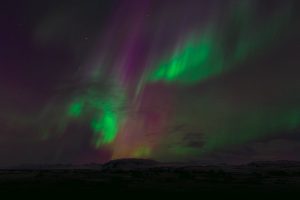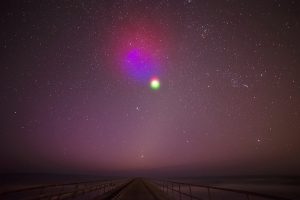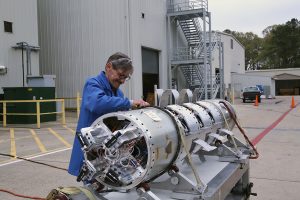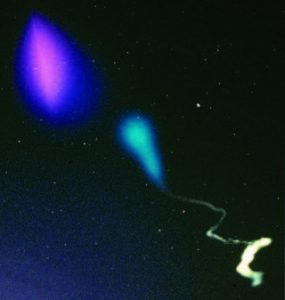
After numerous launch dates that were cancelled or scrubbed due to a variety of factors, the most common of which were weather, NASA’s Wallops Flight Facility is going to try again during the early hours tomorrow morning for this significant rocket launch. Whether it launches or not, Weatherboy will host a special FacebookLive event beginning at 3:45am tonight.
The launch of the NASA Terrier-Improved Malemute sounding rocket is now scheduled for launch between 4:25– 4:48am, Thursday, June 29. The backup launch day is June 30 The launch window is determined by sun angles and also moon down conditions. Thus, this launch window is early morning compared to the previous evening launch window for this mission. The NASA Visitor Center will open at 3:30 a.m. on launch day to view the launch. Live coverage begins on the Wallops Ustream site at 4:00am.
People in the Mid Atlantic will be treated to a special atmospheric event on launch day: the payload on that rocket should trigger a mini, man-made aurora (“northern lights”) over the area with colorful, glowing clouds. During a launch window that extends for 30 minutes, the Terrier-Improved Malemute will take off for the skies as part of an Ampoule Test Launch designed to support science around the study of aurora.

.

During the flight of a two-stage Terrier-Improved Malemute sounding rocket, 10 canisters roughly the size of a can of soda will be deployed into the air 6-12 miles away from the 670-pound main payload. Roughly 4 to 5 and a half minutes later, the canisters will deploy a blue-green and red vapor forming artificial clouds. The vapor tracers are formed through the interaction of barium, strontium, and cupric-oxide. Because these tracers are released at altitudes of 96-124 miles high, NASA says they “pose absolutely no hazard to residents along the Mid-Atlantic coast.”

Photograph: NASA/Berit Bland
Ground cameras in Duck, North Carolina, as well as at the Wallops Flight Facility, will be set to view the vapor tracers. According to NASA, clear skies are preferred, but not required, at both sites for the launch to occur.
This is a brief mission; total flight time is expected to be about 8 minutes long. The payload will eventually land in the Atlantic Ocean about 90 miles from Wallops Island; NASA says the payload will not be recovered.
We asked the scientists with famed website and app “Aurorasaurus” for their thoughts on this launch; they said, “The rocket will release artificial aurora-like clouds that may be broadly visible up and down the East Coast and inland. The clouds last for 10-20 minutes and trace winds in the neutral and ionized upper atmosphere which is not fully understood and otherwise difficult to probe. Usually this type of experiment is done in auroral regions and tracked with arrays of ground-based cameras. The purpose of the launch Sunday is to test improvements in the technology, so its main purpose is not science. However, photographs of the clouds and their evolution from a broad range of vantage points may contain scientifically valuable observations.” Because all observations can be valuable ones, Auroasaurus scientists are encouraging citizens scientists to step outside, look up, and report what they see. “We are encouraging people to submit observations through the Aurorasaurus.org citizen science platform so they can be archived, documented observations. As usual with aurora watching, (have) a clear dark sky and unobstructed view.” Those not visiting the Aurorasaurus website or using the app can also use other social media channels to get their observations out there. “People can also tweet images and our platform will automatically pick them up IF the word aurora is included as well as a named or geo-tagged location. Aurorasaurus users can then up-vote those tweets to find the real-time observations.
There are many ways to watch this rocket launch. The NASA Visitor Center at Wallops will open at 8pm tonight for viewing the flight. Live coverage of the mission is scheduled to begin at 8:30p on the Wallops Ustream site. Or people within the viewing area (shown on the map above) can simply watch outside in light-pollution/obstruction-free skies.

Credits: NASA
While the aurora has been known to dance about bringing vibrant colors to northern latitudes, this man-made light show will not nearly be as large or as bright. Aurorasaurus scientists tell us that this view Sunday night will “definitely look quite different than real aurora.” They tell us, “The lights should be high in the sky and ~60 miles off the coast of Virginia when the experiment starts. If you’re at the coast in Virginia, that’s ~60° off the ocean; not vertical but two-thirds of the way towards vertical in the sky. It will be at a lower angle the farther away you are. The lights will probably not cover a huge area, likely less than the size of your outstretched hand at first. That’s a very approximate estimate. There are actually several separate points of lights possible that start 3-5 minutes after launch. It will be interesting to see how many keen photographers may be able to capture.”
NASA’s Sounding Rocket Program is conducted at the agency’s Wallops Flight Facility, which is managed by NASA’s Goddard Space Flight Center in Greenbelt, Maryland. Orbital ATK provides mission planning, engineering services and field operations through the NASA Sounding Rocket Operations Contract. NASA’s Heliophysics Division manages the sounding-rocket program for the agency.
Sounding rockets like the one responsible for Sunday’s mission were first used in the 1950s, aiding scientific research with experiments which inject vapor tracers in the upper atmosphere. These sounding rocket launches have greatly aided scientists understanding of Earth’s near-space environment. These materials make visible the naturally occurring flows of ionized and neutral particles either by luminescing at distinct wavelengths in the visible and infrared part of the spectrum or by scattering sunlight. The type of vapor selected to create these colorful clouds and trails depends on the purpose of the investigation, the local time, and the altitude under study.
This mission was attempted earlier in June, but scrubbed due to poor weather or wayward boats.